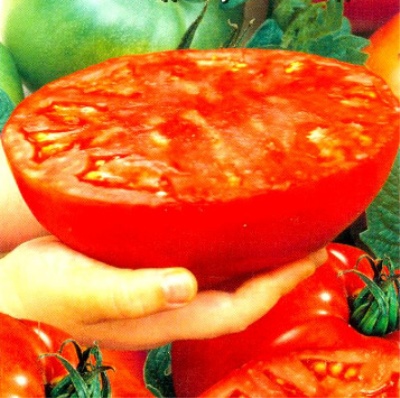
- Category: hybrid
- Growth type: indeterminate
- Appointment: universal
- Ripening period: mid-season
- Ripening time, days: 110-115
- Growing conditions: for film greenhouses, for greenhouses
- Bush size: tall
- Bush height, cm: 150-200
- Bush characteristic: vigorous
- Ripe fruit color: Red
If you want to grow a productive variety of tomatoes with large fruits in a greenhouse, you should pay attention to the Super Steak. This plant is immune to many common diseases and is therefore easier to care for.
Description of the variety
The hybrid variety Super Steak belongs to indeterminate plants with a universal purpose of fruits. Grown in various types of greenhouses.
The bushes are tall, they can reach two meters. The Super Steak tomato is a vigorous plant.
The main qualities of the fruit
Tomatoes are red in color, large, with a maximum weight of 600 grams.
Up to 6 fruits can form in one cluster, about 8 of them are formed on the main stem.
Taste characteristics
Supersteak fruit tastes sweet.
Ripening and fruiting
This variety is mid-season, ripening period - 110-115 days. Harvesting starts in July and ends in September.
Yield
The described variety is high-yielding.
The timing of planting seedlings and planting in the ground
From early to mid-March, Super Steak seeds are planted on seedlings. From mid-May to early June, young bushes can be transferred to greenhouses.

Growing tomato seedlings is an extremely important process, because it largely depends on whether the gardener can harvest at all. All aspects must be taken into account, from seedbed preparation to planting in the ground.
Landing scheme
The ideal planting pattern is 60 x 50 cm, with a density of 3 to 4 plants per square meter.

Growing and care
Containers for tomato seedlings Super steak must be disinfected. The container is filled with the purchased substrate or a mixture of soil, sand and peat in equal parts. The mixture is preheated in the oven for about 15 minutes at 200 ° C.
Seeds are disinfected in 1% potassium permanganate solution. Then they are planted in moist soil in accordance with the 1x3 cm scheme, after which they are covered with a layer of soil 1 cm thick.
The moisture content of the soil is constantly monitored: after drying, the soil is moistened with a spray bottle. If all instructions are followed, seedlings appear in 3-4 days. You can speed up the process by pulling the film over the containers.
When three true leaves appear on a Super Steak tomato, the strongest seedlings are transferred to the greenhouse.
The soil must be disinfected a week before planting. Then fertilizer is applied, compost or rotted manure can be used. A mixture is also suitable: a bucket of peat, humus, sawdust, 50 g of superphosphate and 500 g of ash per 1 square meter.
Watering is carried out in the afternoon with warm, settled water under the root of the plant. Irrigation is carried out once a week 1 liter under a bush. During the Super Steak fruit formation phase, the volume of water increases to 2 liters, and the interval between watering decreases to 5 days.
If possible, it is better to use drip irrigation, which does not allow the ground to dry out, and accordingly, the likelihood of the appearance of plague or apical rot is reduced.
In the future, super-steak tomato is fed twice a month with a solution: 15 g of ammonium nitrate, 50 g of superphosphate and 30 g of potassium, diluted in a bucket of water. For each bush 1 liter. When preparing the solution, it is not allowed that the nitrogen content exceeds the mass of potassium and phosphorus.
After planting the seedlings, a peg is driven in near each plant, the height of which should be 40 cm higher than the plant.Accordingly, if a Super Steak tomato can reach 2 meters, then the support should be 2.4 m high.The stakes are immersed in the ground to a depth of 40 cm from the north side at a distance 10 cm from the stem. It is better to tie it up with special clamps or rope.
The described variety is necessarily pinned and shaped. Leave no more than 2 stems so as not to overload the bushes.




A plant needs different micronutrients at each stage of growth. All fertilizers can be divided into two groups: mineral and organic. Folk remedies are often used: iodine, yeast, bird droppings, eggshells.
It is important to observe the rate and period of feeding. This also applies to folk remedies and organic fertilizers.
Disease and pest resistance
The Super Steak tomato has comparative resistance to late blight and excellent resistance to bacterial spotting, cladosporia and tobacco mosaic virus.
All other diseases are treated with fungicides, and insecticides are saved from the invasion of insects.


Growing regions
Cultivation is allowed in any region of our country.

























































































